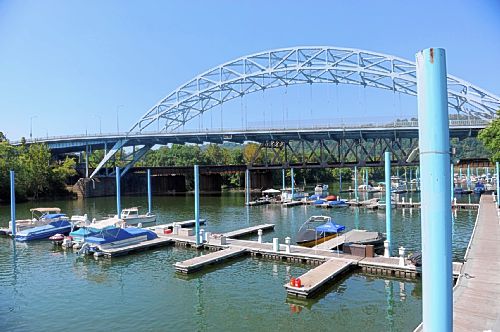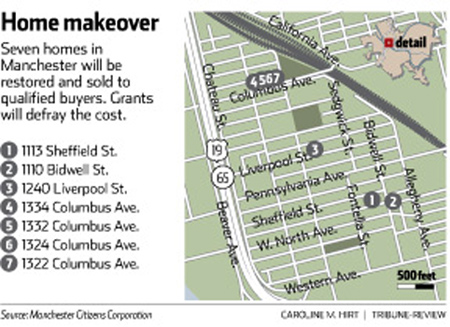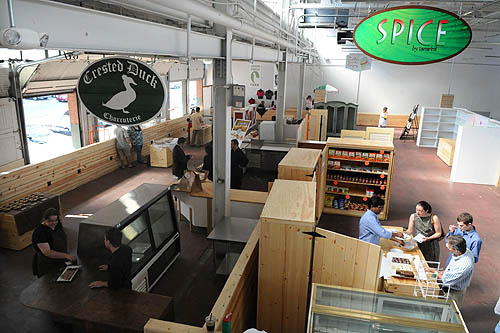
Category Archive: Legislative / Advocacy
-
In McKeesport, Marina’s Success Boosts Other Businesses, City’s Hopes
Thursday, September 09, 2010By Candy Woodall, freelancePittsburgh Post-GazetteSummer may be winding down but Ray Dougherty already is preparing for next season at McKees Point Marina along the Youghiogheny River.
The 200 docks are full to capacity, and the waiting list is growing, a stark difference from the 60 spots that were filled when Mr. Dougherty started as manager of the marina in McKeesport four years ago.
In addition to the solar, steel building he plans to have constructed along Water Street to house boats during the off-season using a $150,000 Growing Greener grant, growth at the marina also has led to a new boat dealer opening in McKeesport and increased revenues at McKees Cafe.
He attributes the surge at the marina to reducing rates and adding entertainment.
The marina hosts free, live entertainment every weekend.
Rates were $1,080 annually for either a 30- or 20-foot dock in 2006. Now, they are $900 per year for a 30-foot dock and $580 per year for a 20-foot dock.
Mr. Dougherty said he puts the docks in the water for the boating season to begin April 15 and takes the docks out when the season ends Oct. 15. The marina also docks 18 jet skis and keeps 11 spots open for transient boaters who can anchor at the space for $20 to $25 per day.
“We keep those prices low to encourage people to come visit McKeesport,” he said.
The marina is now self-sustaining — purchased with a $1.8 million Housing and Urban Development Authority loan in 1998 — and costs about $100,000 a year to operate, he said.
By the beginning of next season, he wants to use marina revenues to build a small park for children near the marina for the families who dock there.
He attributes the surge in family boaters to a slow economy and the other offerings of McKeesport’s waterfront — not the least of which is its use as a trail head to the Great Allegheny Passage, Steel Valley Trail and Youghiogheny River Trail.
The combination of water traffic, foot traffic and boat traffic has boosted sales by 50 percent at McKees Cafe along Water Street, which Mr. Dougherty also manages.
His cafe, which makes its own homemade bread and sells $5 lunches, has a nautical theme, including a large mural of sea life on the walls. Another wall is signed by boaters, bikers and hikers who have visited the trails from seven countries and all but five states.
“We see a lot of bikers in the morning and boaters in the evening,” he said.
Boaters who buy a yearly lease at the marina also have a membership to the McKees Cafe Clubhouse, where they can host birthday parties, graduation parties or other events for free.
Mr. Dougherty said most members are from the Mon Valley or Westmoreland County, including the communities of McKeesport, North Huntingdon and Greensburg.
The boating activity is why Pittsburgh Boat Sales opened on Water Street this summer and celebrated a grand opening a few weeks ago.
“The McKees Point Marina has a central location to Pittsburgh, and we wanted to jump into the Pittsburgh market,” said Dino Ellena, service manager.
“We noticed a growth in boating. Families seem to be forgoing a $7,000 vacation in favor of buying a boat and having many summers of vacation.
“It’s another way to help the economy here instead of going somewhere else and spending money. More people are keeping the money local.”
And that’s great news, said Dennis Pittman, McKeesport city administrator.
He hopes the city’s natural resources — as a confluence of the Youghiogheny and Monongahela rivers — will create other economic opportunities for the city.
He’s making plans to build a fishing pier, establish a rowing club, partner with Penn State Greater Allegheny to construct a fish hatchery and develop the waterfront with small businesses.
Seeking Hope VI grant money, he hopes to use those public funds to build a $100,000 fishing pier at 13th Street along the Youghiogheny River next year.
“I may be dreaming a little because we’re rich in ideas and poor in dollars,” Mr. Pittman said. “But there’s no doubt we need to take advantage of what we have.”
When the Army Corps of Engineers is finished with its work on the Braddock Dam and eliminates the Elizabeth Dam, McKeesport will have a 20-mile pool of free-flowing water to use, doubling the 10-mile pool it has now.
Those changes also will cause the Youghiogheny to rise about 5 feet, according to Mr. Pittman, making boating on that river a more pleasurable experience.
Mr. Pittman also wants to see some rowing boats in the water within the next three years.
He said the city has the space and desire for a rowing club that could host high schools, colleges and junior programs.
He’s partnering with executives at Three Rivers Rowing to establish a program — possibly as a third site for the rowing club, which already operates facilities at Washington’s Landing and in Millvale.
Mr. Pittman would like to see an indoor facility with a glass front built along the water in an old pipe yard. It could include a gym, boat storage and restaurant. He’s seeking public funds, philanthropic support and partnerships with the private sector. He declined to give specific figures while costs are being analyzed and collaborations are forming.
He hopes a partnership with Penn State Greater Allegheny will lead to the creation of a fish hatchery at an old Westmoreland County water plant near 15th Street through the school’s agriculture program.
“We’ve talked to school officials there about raising the fish and stocking our local streams,” he said. “It’s a teaching and vocational opportunity.”
Mr. Pittman said he is talking to John Hohman, plant manager, to work out a ground lease. It also may be donated to Penn State Greater Allegheny or the city, he said.
“The elements are in place, but there’s still some work to be done,” he said.
The economic impact of developing a waterfront and using rivers can be huge, according to Rick Brown, executive director of Three Rivers Rowing.
It takes some work and money, but not necessarily much money, he said. Facilities range in costs, and sometimes boathouses start out with simple materials such as chain-link fencing, he said.
Eight high schools, three colleges and a junior team representing 20 local high schools compete through Three Rivers Rowing. It has 400 adult members, 100 youth members and about 3,000 total participants a year.
Mr. Brown is pleased that another local municipality wants to start a rowing program.
“I think more rowing in the area would help all of us. We’ll be an area better served,” he said.
And McKeesport would have more to offer, Mr. Pittman said.
“We want people to see us as a destination point,” he said. “We just have a lot more potential than what’s been tapped.”
-
McKees Rocks’ Miles Bryan School May Become Condos
Thursday, September 09, 2010By Brian David, Pittsburgh Post-GazetteThe Miles Bryan School building is beautiful in a way modern schools seldom are, with a Gothic flavor and spires and gargoyles carved into its stone.
It’s also in a beautiful spot, on six wooded acres atop a hill jutting up in the midst of McKees Rocks.
The 83-year-old former school has a spectacular view, with the Pittsburgh skyline floating above the treetops to the east and an overview of the town’s rolling hills.
And it boasts a unique bit of landscaping with its terraced levels and sweeping, 102-step grand staircase winding down the hill to Chartiers Avenue.
That’s the good. The bad is that Miles Bryan, vacant since 1997, has been targeted by vagrants and vandals and is marked by graffiti and broken glass.
It is in a struggling community where redevelopment is too often an underfunded dream. And with no one to do official maintenance, a handful of volunteers faces the task of keeping weeds and brush at bay on the grounds.
“I get poison ivy five times a summer up there,” said Taris Vrcek, director of the McKees Rocks Development Corp. and the chief maintenance volunteer.
Mr. Vrcek, however, hopes to put the Calamine lotion away for good in a few years. The CDC, which has an option on the property, is marketing it to developers, touting it as a site for 20 to 30 luxury loft condominiums.
“We see Miles Bryan as a viable and marketable property,” he said Tuesday. “We’re seeking a developer with the imagination to share our vision of what is possible.”
As part of that mission, the CDC on Friday hosted the second annual “Run Your Rox Off” 5K run/walk, which started and finished at Miles Bryan and included a community picnic and free concert.
Mr. Vrcek said the event raised roughly $2,000 for the CDC, but more importantly, it attracted between 300 and 400 to the site, including a high percentage of out-of-town runners.
“The fundraising is definitely secondary to raising awareness,” he said.
Miles Bryan was built in 1927 on an outcropping known as O’Donovan’s Hill, part of the landholdings of telegraph-operator-turned-merchant-banker Michael C. O’Donovan. It was named for a banker and politician who was also a scion of the family that built the Frank Bryan Inc. concrete company.
The building served as the high school for McKees Rocks children until 1966, when McKees Rocks and Stowe merged to form the Sto-Rox School District, then served as Sto-Rox Middle School for another 31 years.
Facing a steep renovation bill, the school district closed it in 1997 and sold it to a developer in 2001. The CDC holds an option with that developer.
Mr. Vrcek said he spent one year there, as a seventh-grader in 1981-82, but has “more memories from there than from anywhere else.”
He remembered the separate rooms for art, wood shop and music, the gym and auditorium and especially the trees.
“It was so easy to focus there; you had trees outside your window and not much else,” he said. “You felt removed from the world up there.”
He also remembered playing on the grounds before and after school, and the long walk up the hill from Chartiers Avenue, where children got off the buses. “It immediately promoted good health, making all the kids walk up that hill,” he said.
Mr. Vrcek said the classrooms are between 1,000 and 2,000 square feet with high ceilings and large windows and would convert easily to apartments. He said that eight of them would most likely boast the skyline view.
The gymnasium, he said, could be used for either sheltered parking or as a fitness center, and the auditorium could get windows and skylights and serve as an atrium-style gathering place or even as an indoor greenhouse/garden.
Mr. Vrcek also said the CDC is interested in keeping the grounds open to the public, while balancing that interest with the privacy and safety concerns of prospective owners.
Duquesne Light has been an active donor to CDC efforts, he said, and he is looking to the utility company’s Power to Light program to get some lighting on the grounds.
Mr. Vrcek said that Duquesne Light also is planning to do cleanup work in Third Street Park, which adjoins the Miles Bryan grounds, as a Day of Caring Project on Tuesday. The park has been closed since the mid-90s, and the CDC is hoping to find funding for new equipment and safety measures to get it open again.
“Talking to young people around here, I know that kids desperately want some decent park space, some decent green space,” he said.
Mr. Vrcek said the hope is to have a developer on board for the Miles Bryan project within 12 months. He is looking at a five-year time frame to have lofts on the market.
-
7 Homebuyers Sold on Manchester Vision
By Adam Brandolph
PITTSBURGH TRIBUNE-REVIEW
Thursday, September 2, 2010
Linda Nelson, chairwoman of the Manchester Citizens Corporation, inspects one of the properties being restored on Columbus Avenue in Manchester. The home was purchased as part of the Great House Sale. Jasmine Goldband | Tribune-Review
For the first time in years, Anthony Clark sees a reason to invest in his North Side neighborhood.
“Manchester is really starting to get going, and after 15 years of renting, I think it’s a good time,” said Clark, 44. “I think we’re about to see some really great things.”
For years, the city demolished vacant homes in Manchester, turning usable buildings into weed-filled lots that became overrun with graffiti and trash. The vacant lots made selling homes difficult, and people living there say the community suffered despite the fact that police records show the number of crimes fell by nearly half over the past decade.
“When you have a tooth out, the disease begins to spread,” said Linda Nelson, chairwoman of the Manchester Citizens Corporation, a community group founded in 1965 that helped spur more than $40 million in developments and initiatives. “If (buildings) come out, it’s definitely a hindrance. If we can renovate them, it’s a plus.”
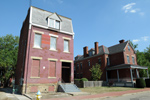
An abandoned structure (left) on the 1100 block of Bidwell Street in Manchester is one of several slated for rehabilitation. Jasmine Goldband | Tribune-Review
With the group’s managing director Stanley Lowe urging the city to save buildings from demolition, the wrecking ball slowed. Along with the Pittsburgh History & Landmarks Foundation, it identified 110 buildings that should be saved, 63 of which are considered a priority.
Lowe said he reminded members of the city’s Historic Review Commission about the neighborhood’s rich architectural and cultural heritage, which helped Manchester achieve city and national historic status in 1979.
“Once you tear down the building, you can never go back,” Lowe said.
In October, the citizens’ group showcased seven homes to be restored by March. More than 100 people, some from as far away as Venezuela and Colombia, attended a two-day session that included a seminar educating them about how to buy one of the homes.
Twenty-five people put down $1,500 deposits, and seven qualified buyers were chosen at random to buy the homes. The rest were put on a waiting list for future restorations.
“The homes were a terrible mess,” Nelson said. “But the people who came in saw our vision.”
The cost to restore each home will range from $150,000 and $450,000, but they will sell for $90,000 to $200,000.
Incentives totaling $2 million for the buyers will be paid by grants from the city’s Urban Redevelopment Authority, the federal Department of Housing and Urban Development, Allegheny County, the Pittsburgh History & Landmarks Foundation’s Landmarks Community Capital Corporation and the Allegheny Foundation.
City Councilman R. Daniel Lavelle, whose district includes Manchester, said the strategy “fits the city’s economic reality.”
“The city can’t afford to do it all at once, so (the citizens’ group has) identified key properties they want to save,” Lavelle said. “I think it’s a tremendous project.”
Preserving the “architectural fabric” of the historic district has been ongoing since the 1970s, said Arthur Ziegler, president of the landmarks foundation.
Rob Stephany, executive director of the redevelopment authority, said the restorations are a “really bright strategy,” especially because they’re near construction at Columbus Square, a $15 million, 31-home development on four acres.
“Manchester has everything working for it,” he said.
-
City’s Newest Indoor Market Opens in Strip Next Week
Wednesday, September 01, 2010By Diana Nelson Jones, Pittsburgh Post-GazetteWhen the Pittsburgh Public Market in the Strip opens Friday, patrons will see some tried-and-true faces — La Prima Coffee, the Common Plea and Fudgie Wudgie among them.
But the new indoor market in the Produce Terminal Building on Smallman Street marks the retail debut of a number of the 43 vendors, whose wares will include organic produce, coffee, specialty meats, pastries, Indian food, pierogies, organic teas, local wines, micro brewed beer, skin care products, knitted goods and jewelry.
The Produce Terminal was built in 1926 by the Pennsylvania Railroad. The market house, located between 16th and 17th Streets, features horizontal roof-line skylights and doors that open for a river view. It will be open Fridays from 9 a.m. to 7 p.m., Saturdays from 9 a.m. to 5 p.m. and Sundays from 10 a.m. to 4 p.m. The grand opening festivities are Sept. 10-12.

Debbie Jacknin of Jenn's Jems displays her jewelry and other items in her booth at the new Pittsburgh Public Market in the Strip District on Tuesday. Robin Rombach/Post-Gazette
The project began almost nine years ago as a dream of Neighbors in the Strip.
“Eight years, three months and two days,” said Tom Goslin, the Market Council president and owner of American Dispatch.
The dream got state funding in 2005, the same year the Urban Redevelopment Authority, which owns the building, did a feasibility study. The URA invested $100,000. The total price tag of $1.25 million was filled out by federal, state and local foundation money.
“This was part of our neighborhood improvement strategy,” said Becky Rodgers, executive director of Neighbors in the Strip. “It’s been a goal of ours to bring back a piece of history to Pittsburgh.”
The city once had four enclosed marketplaces. The last of them closed in 1965 to create Allegheny Center Mall.
Several years ago, the board of Neighbors in the Strip visited existing markets: the Reading Terminal Market in Philadelphia, the West Side Market in Cleveland and the Central Market in Lancaster, hoping to bring a similar concept to the Strip.
Cindy Cassell, market manager, said the market council selected vendors “in the context of the entire Strip. We had a series of meetings with existing businesses and came up with a list of things that would contribute the most diversity to the Strip.”
Edith Davis and Eartha Sewell, of Edith and Eartha Textiles, are among several woman- and minority-owned businesses in the marketplace. They were in a knitting group, then started knitting together, specializing in scarves and wraps.
“People said they wanted to buy them” said Ms. Sewell, “so we thought we could make a business out of it. Then this opportunity came up. You know what they say: Do what you love.”
The first vendor’s space in the markethouse is Kevin and Adam Costa’s Crested Duck Charcuterie, where the brothers are opening their first specialty meat shop. Kevin was mentored by a chef during a stint in Cincinnati, “then I just played with it and tried things. I did vegan baking at a farmer’s market in Indianapolis” before returning home to Pittsburgh last year.
Debbie Jacknin’s 23-year-old daughter Jenn began making jewelry when she was 14. “She taught me,” said Ms. Jacknin. “We’ve done craft shows before but nothing like this,” their first retail presence — Jenn’s Jems.
“A friend told me about this marketplace. I had to submit a video. And they accepted us.”
Diana Nelson Jones: djones@post-gazette.com or 412-263-1626. -
Public Market in Strip to Open Sept. 10, Feature Specialty Items
By Michael Machosky, PITTSBURGH TRIBUNE-REVIEW
Tuesday, August 31, 2010
Siblings (from left), Xanthe Schandelmeier, 5; Coco, 9; and Vivienne, 7, of Squirrel Hill, sample sweets at Prasad Potluri's Spice by Tamarind booth in the Pittsburgh Public Market. More than 40 vendors will showcase their wares in a 10,000-square-foot area of the Produce Terminal Building. The grand opening will be Sept.10. The market will be open Fridays, Saturdays and Sundays. Heidi Murrin | Tribune-Review
From homemade pierogies and duck pate with pistachios and fresh herbs to old-school Italian ice and locally-brewed beer — the Pittsburgh Public Market is so close, you can almost taste it.
“It will be 45 years in November since Pittsburgh had a public market,” said Becky Rodgers, executive director of Neighbors in the Strip, who vividly remembers the last one — the long-demolished North Side Market House. “My great uncle Bob was a butcher there. My whole family used to go — it was like a sight-sound-smell extravaganza.”
Starting with a soft opening Friday, the long-delayed Pittsburgh Public Market finally will open to the public. On Sept. 10, there will be a clamorous Grand Opening marked by the ringing of bells — the public is invited to bring their own to add the racket.
Unlike Pittsburgh’s seasonal farmers markets, this indoor market will be open every weekend year-round. The $1.3-milllion project will have more than 40 vendors in 10,000 square feet of space — which is only a small slice of the blocks-long Produce Terminal Building along Smallman Street, where it is housed. The entrance is near 17th Street.
It’s been a delicate balancing act from the start, which began in 2001. Spaces from 6,500 square feet to 30,000 square feet were considered. And finding a way to avoid diverting business from the Strip’s established food purveyors was a major concern.
“You’ll notice we don’t have a fish place in our market — that’s a very usual kind of thing to have in a market,” said Cindy Cassell, the market manager for Neighbors in the Strip. “We don’t have a cheese place. We’re really working hard not to replicate existing niche markets.”
Vendors quite literally are all over the map — from Gosia’s Pierogies to Sito’s Mediteranean dressings, to Ekh’s authentic Indian vegetarian dishes, to Mushrooms for Life, foraged from around Western Pennsylvania.
Kevin Costa was slicing up duck pate and “Gin & Juice Salami” Tuesday morning at the Crested Duck Charcuterie, a specialty meat market with a booth near the entrance.
“We wanted to start our own business, but it would have been impossible to duplicate the foot traffic of the Strip, so this is perfect,” Costa said.
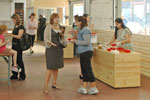
On Sept. 10, the PIttsburgh Public Market will open for business inside the Produce Terminal Building in the Strip District. More than 40 vendors will showcase their wares with everything from baked goods to artwork, barbecues to microbrews. Heidi Murrin | Tribune-Review
Starting a business is a lot less daunting for vendors when they’re paying $25 a day for a 10-foot-by-6-foot booth or $50 a day for a 10-foot-square booth.
“One of our challenges has been to get the concept across that, while this is not necessarily full-time, it’s also not a farmer’s market where you just show up and put your tablecloth down,” Cassell said. “It’s a little more permanent than that. So there is some planning involved for your booth. The booths are small, but from a financial perspective, I think it’s very accessible for a new business.
“We do have a lot of startups that are coming in,” she said. “That’s one of our goals, to incubate new businesses. And you know everything will be realized when they grow up and need a storefront, and can, hopefully, take an empty storefront in the neighborhood.”
Other vendors just want a little more visibility.
The Spice by Tamarind booth stocks Indian spices, snacks, chutneys, ready-to-eat meals and specialties like eggless cakes. Owner Prasad Potluri runs several Indian restaurants and small grocers in the region.
“It’s to make people aware of the restaurants and food,” Potluri said of the reason behind his participation.
For some, it’s simply a way to make it easier for customers to find their product.
Scott Smith, of East End Brewery, always assumed most of the sales for his Big Hop IPA and Black Strap Stout would be wholesale to bars and restaurants. But craft-beer fans just kept searching out the tiny, out-of-the-way brewery.
“We’re in an unmarked building in Homewood, and half our business is walk-in traffic,” Smith said.
Now, customers can sample Fat Gary Nut Brown Ale and Pedal Pale Ale at the Pittsburgh Public Market, and fill up their growlers to take home.
Not everything in the market is edible.
Babouche sells Moroccan crafts, jewelry, scarves and leather goods. Iron Eden is renowned for beautiful ironwork — flowers, trellises, sculpture — often made from recycled scrap metal. Jenn’s Jems features knit and crocheted items, and handmade jewelry.
Markets in other cities — like Cleveland’s West Side Market and Seattle’s Pike Place Market — have become first-day tourist attractions.
The Pittsburgh Public Market is starting on a much smaller scale, of course, but drawing new shoppers to the Strip is part of the plan.
“When we had Campos do a consumer market survey for us in 2006, at that time, we were planning for about 30,000 square feet,” Cassell said. “According to the consumer survey, it would add about 12,000 additional shoppers to the Strip every week. Now we’re scaled back in 10,000 square feet. But one of our goals is to increase the customer base for the entire Strip.”
Pittsburgh Public MarketWhen: Opens Friday, with Grand Opening Festivities Sept. 10-12
Hours: 9 a.m.-7 p.m. Fridays, 9 a.m.-5 p.m. Saturdays, 10 a.m.-4 p.m. Sundays
Where: 17th and Smallman streets, Strip District
Details: 412-281-4505 or website
-
Challenge Grant Generates $100,000 for Historic Religious Properties Program
PHLF News
Wednesday, August 04, 2010Thanks to $25,000 in challenge grants from two anonymous donors, The Pittsburgh History and Landmarks Foundation is reviving its recently troubled Historic Religious Properties Program, which provides matching grants to help congregations perform exterior maintenance on their facilities.
“Since 1997, we’ve been giving an average of 70 to 80 thousand dollars a year in grants. When we hit economic hard times in 2010, we suspended the grant program, because there just wasn’t enough money,” says Carole Malakoff, coordinator for the religious properties program.
With the grant program in limbo, two donors stepped up three weeks ago, giving the foundation 60 days to match the grants. The foundation’s President put up $12,500, and over 288 donors contributed gifts totaling $62,710, bringing the total grant package available for the 2011 grant cycle to over $100,210, making this the most successful annual appeal in the Pittsburgh History and Landmark Foundation’s 46 year history.
Applications for grants will be due by December 1, 2010, and provide matching grants up to $10,000 to Allegheny County churches that are over 50 years old.
“Over the years, the majority of our grants have gone to stained glass window work, roof and gutter repair, and masonry work,” says Malakoff.
As a result of the generous outpouring of support, PHLF has decided to host a technical assistance workshop on September 20 at the Calvary Episcopal Church in Shadyside. Experts will provide demonstrations to members of congregations on green building, handicap accessibility, and all that it entails to maintain a historic building.
“We sent out a letter in June to see if there was enough interest, and we’ve had 30 congregations call to say they are interested. So, we’ve had a wonderful response, and we’re still accepting people to come,” says Malakoff.
The workshops go from 10:30 a.m. to two p.m. Interested parties can contact Carole Malakoff at 412-321-3612.
Sign up to receive Pop City each week.
Source: Carole Malakoff, coordinator for PHLF Religious Properties Program
Writer: John Farley -
Roxian (Theater) Ready for Start of Renovation
Thursday, July 29, 2010By Brian David, Pittsburgh Post-GazetteWhen Andrew Hieber saw a “for sale” sign on the Roxian Theater in McKees Rocks, he had an instant vision.
A musician, he knew the local concert scene. A longtime restaurant worker, he knew entertainment. As the owner of a martial arts and fitness gym, he knew business. As a native of The Rocks, he knew what lower Chartiers Avenue had once been. And as a lucky early investor in America Online stock, he even had a bit of money.
“I had always looked at the Roxian as a great music venue,” with nice acoustics and a size that slotted neatly between the clubs and the stadiums, he said. Built in the late 1920s as a movie theater and used for every conceivable stage show since, the Roxian was well-worn but structurally sound. Mr. Hieber figured he could slap on some paint, work his connections and start bringing in mid-level touring bands.
That was 2004. The vision has taken a couple of beatings since. “I don’t get excited anymore,” Mr. Hieber said. “I got really excited five years, six years ago, and it just got me frustrated.”
But if he starts feeling the rush again, it is excusable — the grand old theater is in the process of being gutted in the first phase of a renovation that should have it open by next year.
The plan is to open a side wall to create space for ticket booths and a new entrance, refurbish the main floor with a new bar area and removable seats, raise the stage for safety and better sightlines and replace the 285 balcony seats with 225 seats sized for modern rear ends. The building is also getting an elevator, new wiring, plumbing and ventilation systems, new bathrooms and new light and sound systems.
In all, the cavernous space — five floors on a 27,000-square-foot footprint — will be able to hold 1,500 for a concert, but also will be able to function café-style for banquets, receptions and smaller shows.
In some ways, all this is possible because of the first beating that was administered to Mr. Hieber’s dream six years ago.
When he inquired about buying the building, he was put in touch with an old Sto-Rox schoolmate, Taris Vrcek, who had recently taken on leadership of the McKees Rocks Community Development Corp. Mr. Vrcek told him the Community Development Corp. was acquiring the building and already had someone lined up to be owner/operator of the theater business.
But he promised to keep Mr. Hieber atop the list if anything happened, and when the original operator bailed out six months later, he gave Mr. Hieber a call.
The next blow came when Mr. Vrcek said the community corporation would rent him the building, but would not sell it.
“I said, ‘Why should I rent it from you when I can own it myself?’ ” Mr. Hieber said. “But he waved the carrot of nonprofit grant money in front of my nose.” The Community Development Corp. could get the kind of support that no for-profit business could.
The final blow made the necessity of that arrangement clear; architectural studies showed that to meet code, the theater would need an elevator and bathrooms with 42 toilets, far beyond what it had. “That kind of tore down my dream,” Mr. Hieber said.
Mr. Vrcek, however, was undeterred. He had a strong vision of what lower Chartiers could be, and the redeveloped Roxian was “the game-changer, the catalyst for the rest of the strategic plan,” he said.
“Bring 1,000 people in here several times a week, imagine what that would do. It would really give us a chance to market some beautiful old buildings.”
The neighborhood already has Hollowood Music Center, a music store with a regional clientele, and the Roxian is catty-corner from the Father Ryan Arts Center, a nonprofit facility that supports visual and performing arts.
Mr. Vrcek sees other clubs and restaurants sprouting, capitalizing on the arts-centered theme. “The Roxian could really make this a destination of choice,” he said.
Mr. Vrcek spent years obtaining a $500,000 grant from the state Department of Community and Economic Development and a $250,000 county grant. He also brought in Dennis Stasa, owner of the McKees Rocks company Penn Interiors, as a private partner. The company is doing the renovation work and will have an ownership stake.
Mr. Hieber described Mr. Stasa as “a visionary” when it comes to the building’s interior. “He’s sure when he’s done with this that he’s going to end up on the cover of Pittsburgh Builder magazine.”
The full flow of Mr. Stasa’s vision may have to wait a while, though. Mr. Vrcek said the focus for now is on getting the building ready for effective use as a concert venue, with the “extra bells and whistles” to follow as money is available.
That puts the current focus on the building’s mechanicals and on bringing the main floor and main stage up to standards.
The “bells and whistles” could be a lot of fun, though, because the building is a maze of half-hidden rooms, like a real-life “The Phantom of the Opera” set.
There are rooms flanking the stage along the back wall, stacking up to the ceiling. These were delicately referred to as “sleeping rooms” in the theater’s club days and could be used as “green room” space for artists.
Mr. Hieber envisions opening a small restaurant in a room above what is now the entrance and a cigar bar in an identical room above that. There’s a lounge between the two entrances that was, until recently, adorned with hanging beads and disco posters. The projection room still holds the original projectors — huge machines from the dawn of the movie era.
And then there’s the basement, a huge space previously used as a sports and dance bar; Mr. Hieber envisions a similar use in the future.
“I’ve been through the building probably 20 times,” Mr. Hieber said, “and every time I find a new space I didn’t know about.”
And standing in the empty, dusty darkness of the main floor, he betrayed the fact that the excitement really is still there.
“It’s going to be awesome,” he said.
-
Historical Groups Left in Lurch by Funding Cuts
By Richard Robbins, Pittsburgh TRIBUNE-REVIEW
Sunday, July 25, 2010
Museum inn keeper and Curator Jim Koontz, of Ligonier, builds a birdhouse that is being modeled after the Laughlintown museum's cook house. Barry Reeger/Tribune-Review
Just two years ago, Soldiers & Sailors Memorial Hall & Museum, the Oakland landmark honoring veterans of all of America’s wars, was on the receiving end of a nice piece of change from Pennsylvania: $260,000.
In 2009, the state’s largesse shrank dramatically, to a mere $30,000.
This year, Soldiers & Sailors is in line to get nothing, a result of a state budget that eliminated grants for historical sites, from the 218-acre Bushy Run Battlefield in Penn Township to the smallest local historical society.
The funding cuts will have a huge impact on groups devoted to local history, according to Ronald Gancas, Soldiers & Sailors president and CEO.
He foresees severe retrenchments, including the continuation of a wage freeze in effect at Soldiers & Sailors since 2007 and the need to recruit and mobilize even more volunteers. The museum’s education department has gone from five full-time and two part-time employees a few years ago to one full-time and one part-time employee today.
“If this trend continues, it will take 50 years to put things back together,” Gancas said.
The 2009 state budget contained $1.7 million for regional and local history, a sum that the state House added after several months in which it appeared there would be no funding for historical groups.
But this time around, there was no late change to rescue local history grants, either for general operations or special projects.
There was lip-service support for public history from members of the General Assembly but nothing more, said Deborah Filipi, executive director of the Pennsylvania Federation of Museums and Historical Organizations.
“We are in a crisis, there is no doubt about it,” Filipi said. “There are some museums that are already hurting. I suspect some of these are not going to survive.”
Jeremy Burnworth, president of the Fayette County Historical Society, said the funding cuts could not come at a worse time for his group, which conducted a ribbon-cutting ceremony Friday at its new museum and headquarters in a renovated 1700s building.
“This is really bad timing,” Burnworth said, adding that the historical society will be “held back without” the state dollars. He was counting on $10,000 from the state and a $10,000 match from the county to help staff the museum and the Searight Tollhouse, both along the National Road.
“We were on track” for the funding, Burnworth said. Now the game plan is to utilize volunteers in place of paid staff.
Tina Yandrick, director of operations for the Ligonier Valley Historical Society, said the expiration of funding meant elimination of summer internships cutting general maintenance “over and above the usual.”
Yandrick noted Compass Inn, a restored Laughlintown stagecoach stop built in 1799, “always” needs refurbishing.
Nevertheless, she said, “we are fortunate we have Compass Inn,” a money-maker for the society that helps to offset the loss of state money.
State funding was “always important money for us,” said Lisa C. Hays, executive director of the Westmoreland County Historical Society, adding that money has been so scarce, “I’m trying to get through this month.”
“We’ve already tightened our belts a lot,” Hays said. She forecast the potential for shorter business hours beginning in 2011 to “save staff time.” However, because the society likely will make a greater effort to raise private dollars, Hays was uncertain if savings are actually possible.

